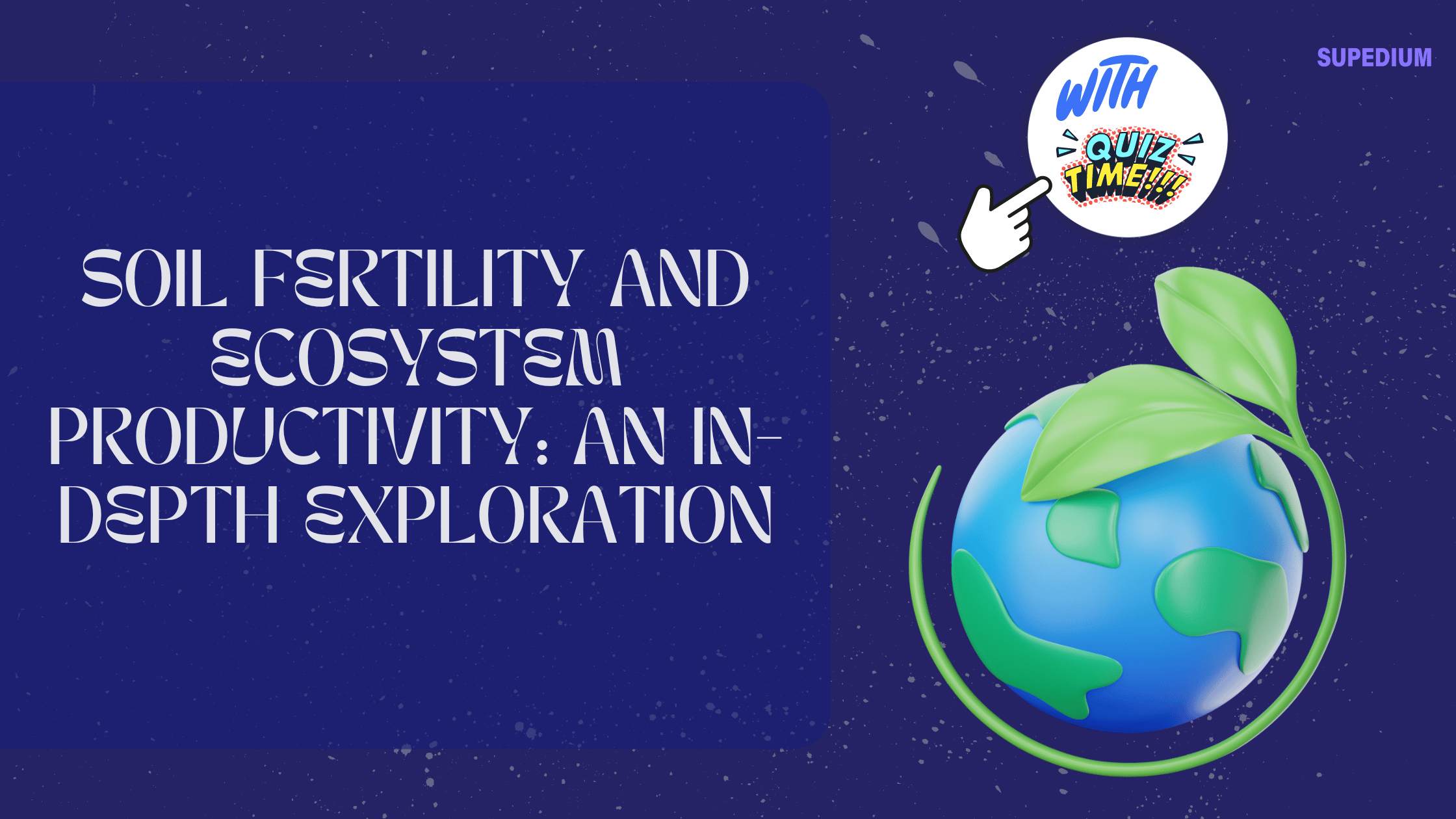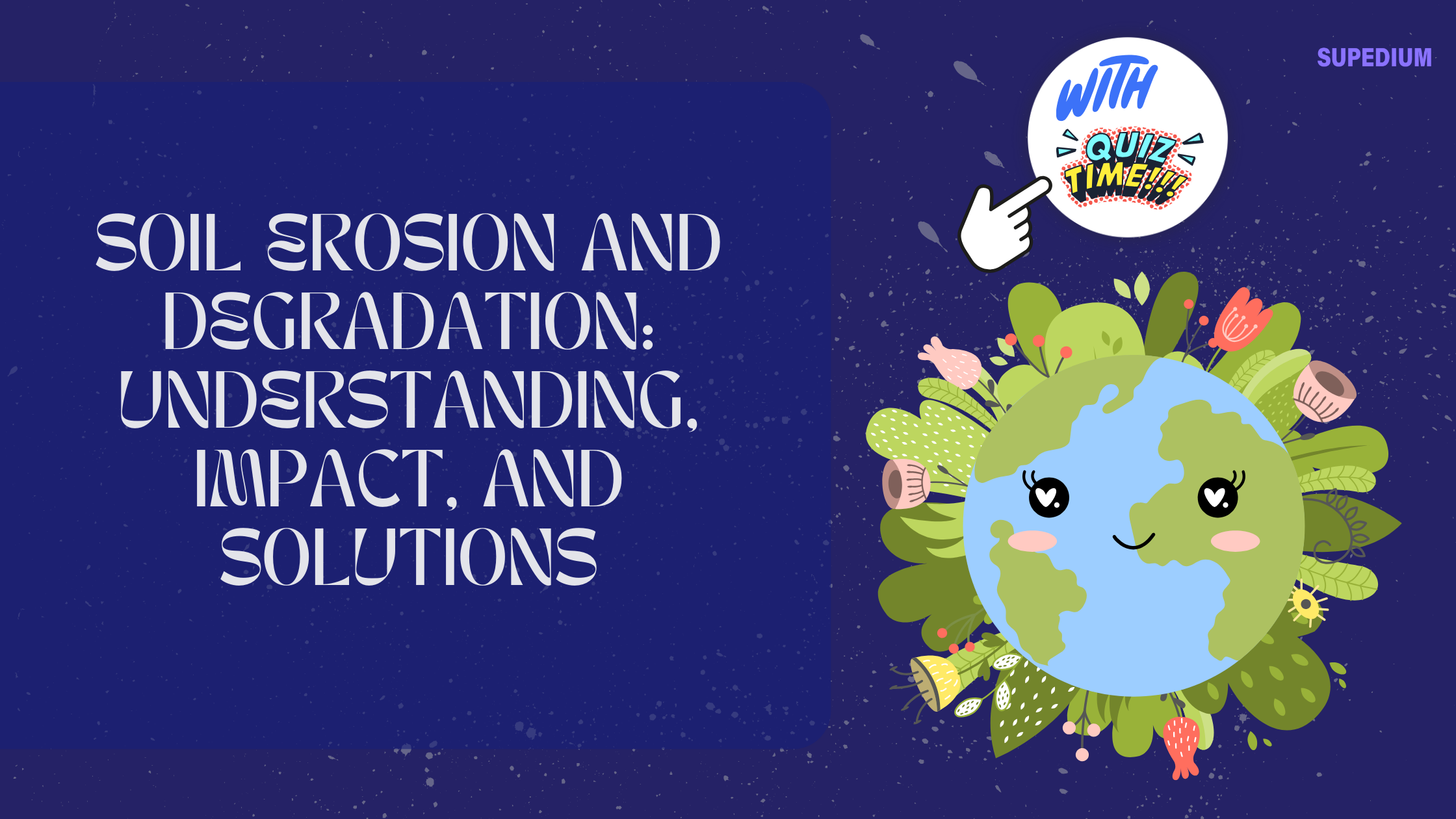Table of Contents
- 0.1 Introduction
- 0.2 Importance of Soil Fertility in Ecosystem Productivity
- 0.3 Factors Affecting Soil Fertility
- 0.4 Soil Fertility Management Practices
- 0.5 Ecosystem Productivity and Its Components
- 0.6 Case Studies and Examples
- 0.7 Environmental and Societal Implications
- 0.8 Future Directions and Research Needs
- 0.9 Conclusion
- 1 Quiz Time
![]()
Introduction
Definition of Soil Fertility
Soil fertility is the capacity of soil to supply essential nutrients to plants in adequate amounts and proper proportions. Essential nutrients include macronutrients like nitrogen (N), phosphorus (P), and potassium (K), which are critical for plant growth, as well as secondary and micronutrients such as calcium, magnesium, sulfur, and trace elements. Fertile soil supports robust plant growth, leading to healthy ecosystems and productive agricultural systems.
Definition of Ecosystem Productivity
Ecosystem productivity refers to the rate at which energy is converted into biomass by primary producers, such as plants and algae, through photosynthesis. This primary productivity is the foundation of the food web, influencing the biomass of herbivores (secondary productivity) and, consequently, higher trophic levels. Primary productivity is a key indicator of ecosystem health and efficiency.
Importance of Soil Fertility in Ecosystem Productivity
Relationship between Soil Fertility and Plant Growth
Soil fertility directly impacts plant health and growth. Nutrient availability affects plant development, influencing factors such as root strength, leaf growth, and flowering. Well-fertile soil ensures that plants have access to the essential nutrients required for photosynthesis, which is vital for biomass accumulation and overall plant vigor.
Soil Fertility and Primary Productivity
Soil fertility is critical for primary productivity. Nutrients such as nitrogen, phosphorus, and potassium are pivotal in enhancing photosynthesis and biomass production. Fertile soils support diverse plant communities and maintain ecosystem stability by providing the necessary nutrients for a variety of plant species, which in turn supports a complex food web.
Factors Affecting Soil Fertility
Soil Composition and Structure
Soil composition, including the proportions of sand, silt, and clay, affects its fertility. Sandy soils drain quickly but may lack nutrients, while clay soils retain nutrients but may be prone to waterlogging. Soil organic matter, including humus, improves soil structure, enhances nutrient and water retention, and supports microbial activity, all crucial for maintaining soil fertility.
Soil pH and Nutrient Availability
Soil pH influences nutrient availability by affecting the solubility of essential nutrients. Most nutrients are readily available in slightly acidic to neutral soils (pH 6-7). Acidic soils may require liming to raise the pH, while alkaline soils may need acidifying agents such as sulfur to improve nutrient availability.
Soil Moisture and Water Management
Soil moisture is essential for nutrient uptake. Adequate moisture allows for the movement of nutrients into plant roots. Effective water management practices, such as irrigation and proper drainage, prevent nutrient leaching and ensure that plants receive consistent water supply, thereby supporting soil fertility.
Biological Factors
Soil microorganisms, including bacteria and fungi, play a significant role in nutrient cycling and organic matter decomposition. These microorganisms break down organic material, releasing nutrients into the soil. Soil fauna, such as earthworms and insects, further enhance soil health by improving soil structure and aeration, promoting better nutrient availability.
Soil Fertility Management Practices
Organic Amendments
Organic amendments, such as compost and manure, enhance soil fertility by increasing organic matter and microbial activity. Composting and the use of green manures or cover crops can replenish nutrients and improve soil structure. Organic amendments contribute to long-term soil health and sustainability by promoting a balanced nutrient cycle.
Inorganic Fertilizers
Inorganic fertilizers supply essential nutrients quickly and in precise amounts. However, over-reliance on chemical fertilizers can lead to nutrient imbalances and environmental issues such as water pollution and soil degradation. Integrated use of both organic and inorganic fertilizers can optimize soil fertility while mitigating adverse impacts.
Conservation Tillage and Soil Erosion Control
Conservation tillage practices, such as no-till or reduced tillage, minimize soil disturbance and preserve soil structure. Techniques to control soil erosion, such as planting cover crops and establishing terraces, prevent nutrient loss and protect soil health. These practices contribute to maintaining soil fertility and enhancing ecosystem productivity.
Ecosystem Productivity and Its Components
Primary Productivity
Primary productivity is influenced by several factors, including light, temperature, and nutrient availability. High primary productivity is typically observed in ecosystems with abundant sunlight, suitable temperatures, and fertile soils. Variability in primary productivity across different ecosystems, such as forests, grasslands, and wetlands, reflects the interaction of these factors.
Secondary Productivity
Secondary productivity, or the biomass production by herbivores and predators, depends on the availability of primary productivity. Efficient energy transfer between trophic levels and the health of primary producers are crucial for sustaining secondary productivity. Healthy and fertile soils support high primary productivity, which in turn supports diverse and productive herbivore populations.
Case Studies and Examples
Agricultural Systems
In high-input farming systems, the use of synthetic fertilizers and advanced technology can significantly boost soil fertility and crop yields. For example, precision agriculture techniques optimize nutrient application and reduce environmental impacts. Conversely, low-input systems that rely on organic practices, such as permaculture, emphasize soil health and sustainability, demonstrating successful soil fertility management.
Natural Ecosystems
Tropical rainforests exhibit high primary productivity due to their warm, moist conditions and nutrient-rich soils. However, nutrient cycling in these systems is rapid, leading to low soil fertility if vegetation is removed. Temperate grasslands, with their deep-rooted plants, maintain soil fertility and productivity through extensive root systems that enhance nutrient cycling and soil structure.
Environmental and Societal Implications
Impact of Soil Fertility on Environmental Sustainability
Soil fertility affects biodiversity and ecosystem services by supporting a variety of plant species and maintaining ecological balance. Soil degradation, caused by erosion, nutrient depletion, or contamination, can lead to reduced ecosystem productivity and loss of biodiversity. Sustainable soil management practices are essential for preserving environmental health and ecosystem services.
Socioeconomic Aspects
Soil fertility is crucial for food security and agricultural productivity. Fertile soils lead to higher crop yields and better quality produce, supporting local economies and livelihoods. Effective soil management policies and practices can enhance agricultural sustainability, improve food security, and reduce socio-economic disparities.
Future Directions and Research Needs
Advances in Soil Science and Fertility Management
Emerging technologies, such as precision agriculture and soil health monitoring systems, offer new ways to manage soil fertility and enhance ecosystem productivity. Research into soil biology, nutrient dynamics, and innovative management practices will contribute to more sustainable and productive soil management strategies.
Climate Change and Its Impact
Climate change poses potential risks to soil fertility and ecosystem productivity through altered precipitation patterns, temperature shifts, and increased frequency of extreme weather events. Adaptation strategies, such as developing climate-resilient crops and improving soil conservation practices, are crucial for maintaining soil health and ecosystem productivity in the face of climate change.
Conclusion
Summary of Key Points
Soil fertility is fundamental to ecosystem productivity, influencing plant growth, primary productivity, and the overall health of ecosystems. Factors such as soil composition, pH, moisture, and biological activity play critical roles in maintaining soil fertility. Effective soil management practices and understanding the interplay between soil and ecosystem productivity are essential for sustainable agriculture and environmental health.
The Interconnectedness of Soil Fertility and Ecosystem Productivity
Soil fertility and ecosystem productivity are deeply interconnected. Healthy, fertile soils support vibrant plant communities, which in turn sustain diverse and productive ecosystems. Integrated approaches to soil management and ecosystem conservation are vital for ensuring long-term environmental sustainability and productivity.
Final Thoughts on Sustainable Practices and Future Outlook
Sustainable soil management practices are crucial for maintaining soil fertility and ecosystem productivity. As we advance our understanding of soil science and address the challenges posed by climate change, adopting innovative and holistic approaches will be key to achieving a balance between agricultural productivity and environmental stewardship.






Be the first to comment